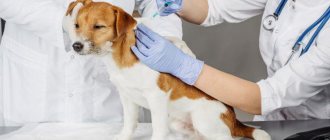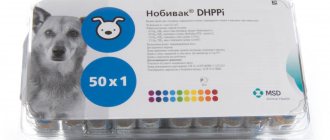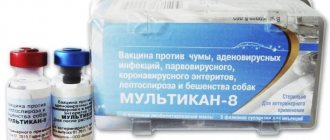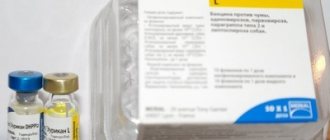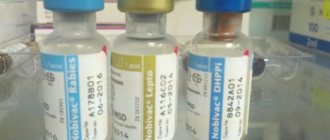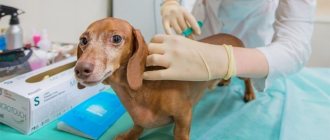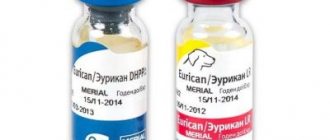Rabies is an infectious disease of a viral nature. There is currently no effective treatment against this disease. The only measure to prevent infection is vaccination.
A timely vaccination against rabies for a dog can save its life, since in accordance with the requirements of the veterinary legislation of the Russian Federation, an infected animal must be destroyed.
In this article we will tell you how often to vaccinate your dog against rabies, its validity period, when re-vaccination is necessary, and what side effects the procedure may have.
Characteristics and danger of rabies
The causative agent of rabies is the rhabdovirus family, which affects the central nervous system. As a result of infection, the animal experiences damage to the nerve endings and gradual failure of the spinal cord and brain.
The main symptoms of this dangerous disease include the following:
- hydrophobia (refusal to drink, uncontrollable fear at the sound of dripping water);
- aggressive or apathetic behavior;
- copious foamy saliva caused by a violation of the swallowing reflex;
- perverted appetite (eating inedible objects).
A sick dog must be isolated in a separate room and not contacted until the veterinarian arrives. The virus is equally dangerous for all warm-blooded animals, including humans. In the final stage, it causes laryngeal paralysis or cardiac arrest.
In the absence of vaccination and the appearance of at least one of the listed symptoms, the chances of salvation are close to zero. Due to the lack of a cure, the only humane solution is euthanasia.
How is rabies vaccination carried out?
Before administering the rabies vaccine to an animal, it is examined by a veterinarian, collects an anamnesis, measures body temperature, and, if necessary, prescribes additional examinations.
If any pathologies are identified for which it is undesirable to vaccinate against rabies, additional treatment may be prescribed.
In the absence of contraindications, vaccination is carried out. The drug is injected under the skin in the withers area.
Then the doctor administering the vaccination puts a note about it in the animal’s veterinary passport, his signature and seal. Also, the veterinary passport must contain a label from the product used for vaccination.
Why is vaccination so important?
Regular vaccination of pets is necessary to reduce the epidemiological burden in cities, so every responsible owner must follow the vaccination schedule. This procedure is the only effective way to prevent rhabdovirus infection.
After vaccination, no more than 2-4% of animals become infected. But even with such an unfavorable outcome, the mortality rate is almost zero. A vaccinated dog with suspected infection is vaccinated again to increase the body's resistance.
In order not to die, you need to know everything about rabies
In order for you to find out the answers to all your questions, you will have to dive deeper into the topic. Well-known veterinary medicine (veterinary medicine) is an area of scientific knowledge and practical activity aimed not only at combating animal diseases, but also at protecting people from zooanthroponoses , producing sanitary-quality animal products and solving veterinary and sanitary problems of environmental protection.
Zooanthroponoses are diseases common to animals and people, in which the source of pathogens for humans is our little brothers. That's why…
The main goal of combating the rabies virus among animals is primarily to protect people!
Russian legislation
Vaccination against rabies in dogs is included in the mandatory list of vaccinations in Russia. Unvaccinated pets are prohibited from traveling abroad, participating in exhibitions and breeding. They may also be refused admission to some veterinary clinics, citing an increased risk of infection.
Thanks to its consolidation at the national level, the vaccine is administered completely free of charge. This service is provided by regional government clinics. Please note that this social program only applies to vaccines containing rhabdoviruses. Vaccination against other infectious diseases is carried out only on a paid basis.
Why do you need to vaccinate your dog against rabies?
Rabies is a highly contagious disease that poses a danger to mammals, including humans. The source of infection is infected dogs, cats, foxes, and rodents. The causative agent of rabies is contained in the saliva of sick individuals and is transmitted by a bite.
There is currently no effective therapy, and when a dog gets rabies, it always dies from suffocation.
Vaccination against rabies is controlled by veterinary supervision.
There are a number of cases when it is necessary to vaccinate your dog against rabies:
- when traveling with an animal abroad;
- when participating in exhibitions and competitions;
- the animal is intended for breeding;
- when leaving an animal for foster care;
- the area in which the dog lives is recognized as unfavorable for rabies;
- Some veterinary clinics refuse to accept unvaccinated animals.
Find out more about rabies in dogs.
How animals are vaccinated
When vaccinated, four-legged patients are injected with weakened or dead fragments of the viral code, which stimulate the production of T-lymphocytes. Thanks to these antibodies, the immune system not only destroys the invading pathogen, but also remembers how to fight the infection. In the future, this allows the production of protective cells without additional stimulation immediately after infection.
Over time, the immune response weakens. For this reason, the vaccinated animal is revaccinated or re-vaccinated.
When is the first vaccination given?
Passive immunity acquired from the mother deteriorates at approximately 2 months, when breast milk production stops. From this moment on, the baby begins to be vaccinated. The rhabdovirus vaccine is administered last, when the puppy approaches 3-4 months of age.
Adjustment of the recommended period up or down is possible in the following cases:
- copious amounts of milk with a small litter;
- diligent avoidance of places with large concentrations of animals;
- no need to travel abroad;
- early weaning from mother;
- crowded content;
- there is a need for urgent relocation;
- a sudden outbreak of an epidemic in the area.
The maximum period of grafting is 6-9 months. Please note that puppies under 2 months of age are rarely vaccinated, as their bodies do not always produce a strong immune response. This is due to the presence of passive immunity that has not yet weakened.
Revaccination schedule
If the drug is introduced too early, revaccination is carried out after 3-4 weeks, and with the standard one - only after 1 year. All subsequent revaccinations are carried out annually - or once every 3 years. The latter option is suitable for animals with weakened immune systems and chronic diseases.
Disinfection and quarantine
After contacting a medical institution, the public service will definitely disinfect the premises where the infected animal was possibly present.
After biting a person, the dog or cat will most likely be taken to a special veterinary facility for quarantine. If the animal dies during this period, doctors will necessarily take biomaterial to accurately confirm the diagnosis.
State budgetary institution Moscow Station for the Control of Animal Diseases (State Budgetary Institution “Mosvetstation”, Moscow, Yunnatov St., 16A) is the only veterinary institution in a huge metropolis where, in accordance with veterinary legislation, inpatient quarantine of animals that have been bitten is carried out people or animals, as well as those suspected of having a disease or being infected with rabies.
Preparation for the procedure
The main cause of complications after the procedure is non-compliance with recommendations for preparation and post-vaccination quarantine. 2 weeks before the event you need:
- Regularly measure temperature and monitor stool quality. The appearance of alarming symptoms is a serious reason to postpone vaccination, so be sure to make sure that your pet is completely healthy.
- Stick to your usual diet, avoiding introducing new foods. You will only have to refuse food 4 hours before the start of the event.
- Treat against ecto- and endoparasites. In case of direct infection, the date of the procedure will have to be postponed.
Special care will be required when preparing the puppy. Before vaccination, the baby is prohibited from contacting other animals and people dressed in outerwear and street shoes.
Deworming
Deworming is a prerequisite, without which the animal is not allowed to be vaccinated. Usually, owners give an anthelmintic drug 10 days before vaccination, but there are also general recommendations:
- Carrying out a stool analysis - if worms or prerequisites for their appearance are detected, deworming is carried out;
- If a repeat stool test 10 days after taking the drug reveals larvae or worms again, repeat deworming is carried out, followed by a vaccine 10 days later.
Vaccine selection
Anti-rabies drugs for dogs differ in the manufacturer and the number of viral code fragments they contain. According to the first criterion, they are divided into domestic and foreign, and according to the second - into mono- and polyvaccines. Each of them has its own advantages and disadvantages, which you should familiarize yourself with in advance.
Nobivac R and RL
The Dutch Nobivak is recognized as the best rabies vaccine for dogs. It is produced in the form of monovaccine Nobivak R and polyvaccine Nobivak RL. In the second case, the vaccinated animal receives protection not only from rhabdoviruses, but also from leptospira.
A monovaccine is a more gentle drug that promotes the high-quality production of antibodies to a specific infection. When a polyvaccine is administered, antibodies to different diseases can suppress each other, but this phenomenon is typical with a multicomponent composition of 6-7 elements. Nobivak does not have such a problem, so for shy pets who cannot stand people in white coats (to avoid frequent trips to the clinic), you can safely choose Nobivak RL.
Biocan
This polyvaccine is produced in the Czech Republic. In addition to rabies, it protects against infectious hepatitis, parvovirus enteritis, parainfluenza, canine distemper, adenovirosis and leptospirosis. As many as 7 components fully explain the fact that dogs vaccinated with Biocan often develop one of the listed diseases. Most often, the antibodies responsible for fighting parvovirus are suppressed.
Rabiks
Rabix is a domestic mono-vaccine, attractive at a low price. It's hard to find any reviews on it. But this is precisely why you don’t have to worry about possible side effects, because in most cases, owners always share their negative experiences on the appropriate forums. But the positive aspects are often missed, taken for granted.
Rabizin
The French drug Rabizin gives a fairly stable immune response, lasting almost 3 years. It is recommended for dogs weakened by chronic pathologies and pregnant bitches. The only drawback is the periodic occurrence of allergic reactions. For this reason, after vaccination, it is recommended to stay at the veterinary clinic for at least 30 minutes.
Rabikan
Another Russian mono-vaccine offered in state veterinary clinics. Despite the rather strong side effects, it gives a quick (within 5-7 days) and persistent (up to 2 years) immune response.
Defensor 3
The American monovaccine Defensor-3 is often used in combination with the drug Vanguard Plus from the same manufacturer. Depending on the epidemiological situation, it is administered annually or once every 3 years. Some dogs may experience an allergic reaction.
The spread of rabies – horror stories or real losses?
In 2022, at the largest annual National Veterinary Conference (NVC), the results on rabies were summed up.
Calculations were carried out, from which it follows that at the moment dogs (39%), foxes (25%), cats (24%), raccoon dogs (6%), small and cattle (2 each) are considered carriers and vectors of rabies. %) and hedgehogs (2%).
According to the World Health Organization (WHO), about 60 thousand people die from rabies every year worldwide, 40% of whom are children under 15 years of age. Every year in Russia there are 400-450 thousand people affected by attacks by street animals.
For such victims, a huge budget is allocated for therapeutic and preventive therapy: the introduction of anti-rabies immunoglobulins and vaccination of people against rabies. In December 2019 alone, 132 cases of rabies were recorded in Russia. Until now, the epidemiological situation regarding the incidence of rabies in Russia remains unstable - from 2012 to the present, 30 deaths among people have been registered.
In the Moscow region in 2022 and the first half of 2019, a worsening of the epizootic situation regarding rabies was revealed. There is a very high number of people seeking help from medical institutions after being injured by animals, and deaths have also been recorded. In just 6 months in 2022, more than 198 thousand people applied, of which more than 53 thousand were children under 14 years of age.
How is rabies transmitted?
Is it possible to get an anti-rabies vaccine yourself?
Despite the simplicity of the procedure, self-administration of the drug should be avoided. Otherwise you risk:
- Violate the conditions for transportation, storage and use of the vaccine, which threatens a decrease in effectiveness and complications.
- Be left without a veterinary passport. This important document is issued only in veterinary clinics.
- Losing a pet due to a sudden attack of anaphylaxis (allergic suffocation). It is almost impossible to cope with an acute allergic reaction at home, so you should not risk your pet’s health.
Remember that before vaccination you need to undergo diagnostics. This is necessary to exclude hidden diseases that complicate the development of an immune response.
When is the best time to vaccinate a child?
Pets can be vaccinated from the age of two months, before which they receive immune cells from their mother’s milk. In general, usually responsible owners and breeders take their children to undergo the necessary manipulations at the age of three, three and a half months.
At the first administration, vaccination is carried out twice with an interval of three to four weeks. Immunity develops within three weeks, so it is important to get vaccinated in advance before traveling.
Post-vaccination period
The duration of this period takes 2-3 weeks. During this time, it is recommended to reduce physical activity, increase the comfort of housing and minimize contact with the outside world.
What condition will the dog have?
Everything here is very individual. Some pets retain their activity and appetite, while others suffer from side effects for several days. The owner can only monitor the pet’s condition, preventing the occurrence of life-threatening complications.
Quarantine
Going outside is allowed only on the 4th day after revaccination. At this point, the likelihood of infection from other animals is minimized, since the body has time to produce protective antibodies. Give your pet a rest and do not burden him with following commands.
After the first vaccination, puppies are kept within the walls of the house for much longer - 14-15 days. This is the only way to protect the baby from the negative effects of the external environment.
In addition to walking, it is recommended to avoid swimming, as any draft can lead to a cold. Also, do not get the injection site wet.
During the quarantine period, you should avoid introducing new products to avoid an allergic reaction. The move will also have to be postponed. Traveling to a new place of residence will be safe only a month after vaccination.
First vaccination
During vaccination, a small amount of the causative agent of the virus is injected into the body. If the puppy is too small and weak, side effects may occur. Therefore, vaccination is not recommended for puppies under three months of age.
It is better to carry out the first vaccination at home, in a familiar environment for the baby.
For modern drugs, changing teeth is not considered a contraindication to injection, but try to get the injection before baby teeth begin to fall out or after they are completely replaced by permanent ones.
Puppies are re-vaccinated against rabies every year. It is important to record all vaccinations in the animal’s veterinary passport: enter the date, name and dosage of the drug.
The first anti-rabies injection is given separately, subsequent ones can be part of complex vaccines.
Complications and side effects
The canine rabies vaccine causes a temporary decrease in immunity. Because of this, the following side effects may occur soon after the procedure:
- decrease and loss of appetite during the first day;
- temperature rise within 39.5°C and loss of activity for 3 days;
- pain and temporary lameness, disappearing after 4 days;
- a single attack of vomiting or diarrhea;
- the appearance of a small lump at the injection site, which resolves on its own within a month.
The help of a veterinarian will be required only if the pet’s well-being deteriorates, the lump suppurates and grows, as well as an acute allergic reaction. An attack of anaphylactic shock is easily recognized by swelling and pallor of the mucous membranes, profuse salivation and difficulty breathing. If these symptoms occur, the animal should be given an antihistamine and urgently taken to the nearest veterinary clinic.
First aid for humans and dogs after being bitten by a suspicious animal
First aid for a person and a dog after a bite is to mechanically remove the pathogen that has entered the wound, so immediately after the incident :
- the one who will provide first aid must wear any rubber gloves;
- you need to wash the bite site for a long time and intensively using soap under running water;
- during washing, it is advisable to deliberately squeeze blood out of the wound;
- after thorough rinsing, dry the wound and liberally apply any antiseptic (alcohol, vodka, miramistin, etc.) to destroy any virus that may have entered;
- be sure to apply a bandage over the wound (you cannot cauterize the wound or apply stitches yourself);
- immediately contact the nearest emergency room (for humans) or veterinary clinic (for animals) - the longer it takes the bitten person to get to a medical facility, the higher the likelihood of contracting rabies;
- It is imperative to carry out a therapeutic course prescribed by a doctor.
The rabies virus is very unstable, therefore, well-provided first aid and timely treatment, as a rule, prevent the development of rabies in humans.
For dogs and cats, the risks of contracting a fatal disease still remain high , since even an unscheduled introduction of a rabies vaccine does not provide 100% protection in this case, since antibodies may not have time to develop in time to prevent the development of a fatal disease (everything will depend on this). from the incubation period). Therefore, well-provided first aid and preventive vaccination given no more than one year ago play an important role here.
Treatment of rabies. Help after a bite.
Basic human treatment
Treatment of a person will be effective only in the period BEFORE the first signs of rabies appear. If you seek medical help only at the first signs, then the treatment will be ineffective, and this means 100% death.
Unfortunately, there is no anti-rabies therapy that can cure a person after symptoms appear. Hence the conclusion - the first aid provided and anti-rabies therapy from the first day of injury will play a huge role.
The main treatment of people is carried out according to a strictly approved protocol and under the strict supervision of a doctor. Fortunately, it is no longer necessary to take 40 injections in the stomach. Nowadays, more modern drugs are used in medicine - rabies immunoglobulin and rabies vaccine (rabies vaccine). Currently, anti-rabies therapy includes only 6 injections in the shoulder area (deltoid muscle) and thigh.
Features of human treatment
It should be borne in mind that these are not strict patterns of care, since the doctor can prescribe a regimen individually for a particular person, after weighing all the facts.
When an unvaccinated dog that has bitten a person is available for observation for 10 days (lives at home or with a neighbor), then initially the person is given only 2 injections of the rabies vaccine. It is also necessary to treat the wound (bite site) with anti-rabies immunoglobulin. If the dog does not show symptoms of rabies during these 10 days, then the human treatment ends there, since both are not infected.
However, if the dog is unavailable for observation (street) or it dies in a short time, then the person who managed to seek help in the first three days after the bite is immediately injected with rabies immunoglobulin, and then immediately with the rabies vaccine, but in a different place.
If you are bitten by a dog that was vaccinated no later than a year ago, then first of all you need to compare the facts - the behavior of the dog or cat in general, whether the pet intentionally bit a person or whether this action occurred because it was teased, etc.
In any case and if you have any doubts, be sure to visit a doctor! Remember, there is no cure for rabies, but you can prevent its development.
For people with obvious signs of rabies, it is only possible to alleviate the suffering as much as possible by using sedatives, administering drugs against seizures and installing a tracheostomy with further connection of the patient to an artificial respiration apparatus. Tracheostomy is the insertion of a special tube into the trachea to ensure air flow into the respiratory tract.
